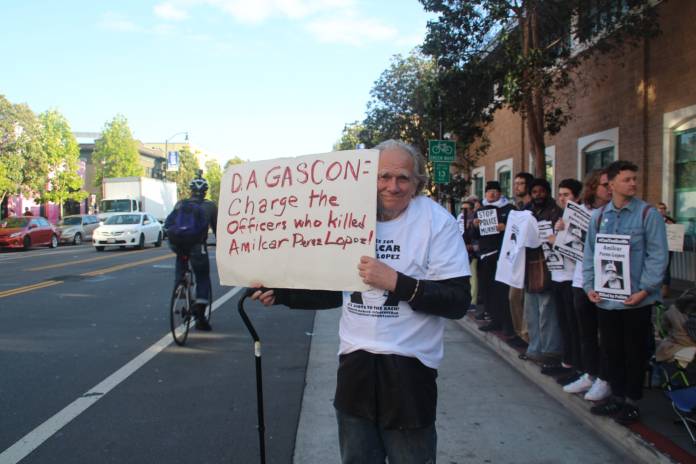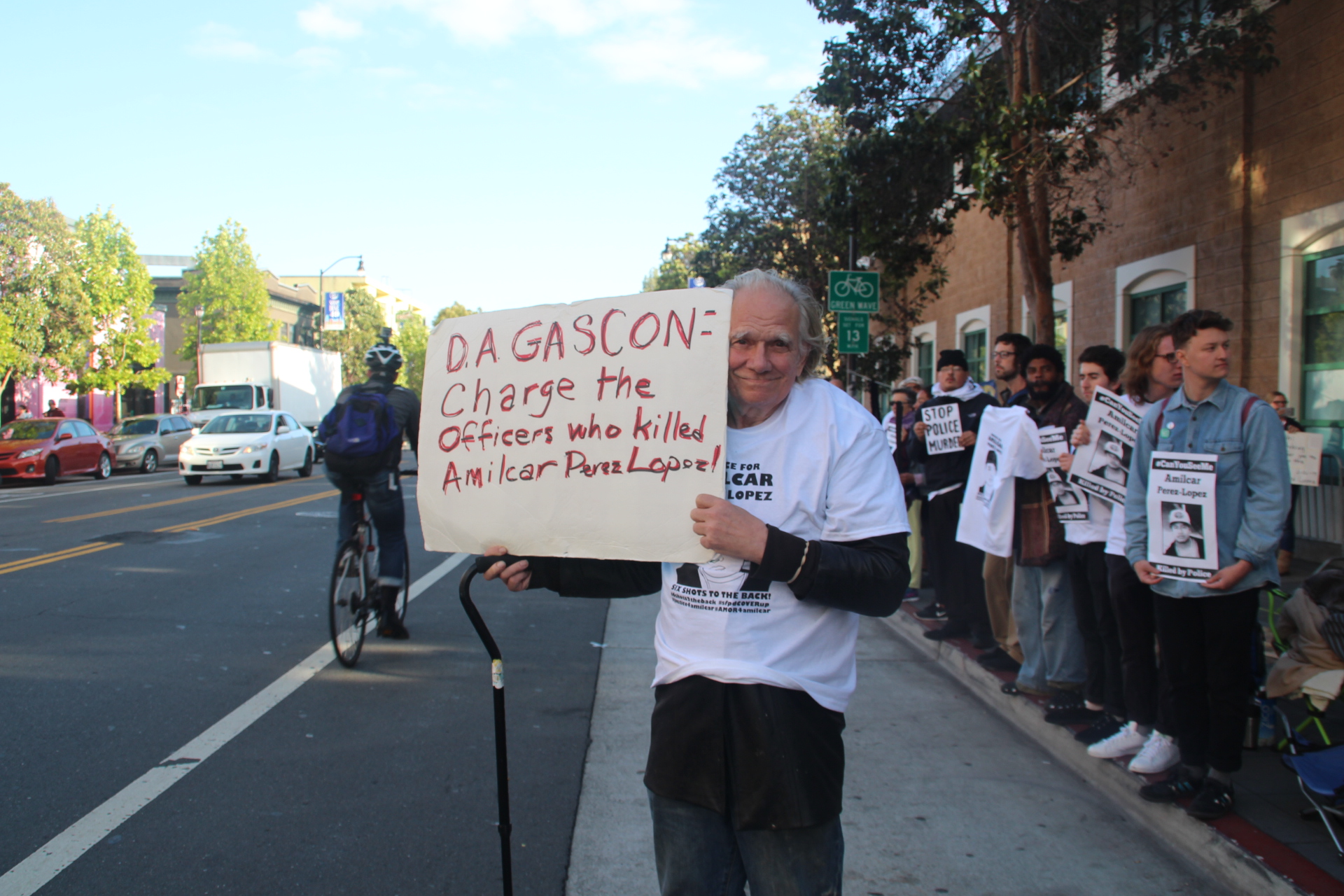
In exonerating the police officers who shot and killed 21-year old Mayan Guatemalan immigrant Amilcar Perez Lopez on February 26, 2015, District Attorney (and former Police Chief) George Gascón has either made himself the willing dupe of the cops or deliberately joined a cover-up.
His report—of which we only have a 27 page summary—resolves contradictory evidence in favor of the officers, omits details that are unhelpful to them, and enlists a so-called expert to explain, in feats of mental gymnastics, how officers who first claimed Perez Lopez was lunging at one of them managed to shoot him six times in the back of his body.

Officers Eric Reboli and Craig Tiffe say they responded to a 9:45 pm report of a man chasing another down Folsom Street near 24th Street with a knife. The genesis of the dispute, and how serious or not the altercation was, is in question. Upon arrival, the cops say they encountered the two men facing each other across a parked car. One (Amilcar Perez Lopez) was leaning against it and looking over the roof from the sidewalk. The other (Abraham Perez) stood in the street.
Officer Reboli says he walked Abraham P. around the front of the parked car toward the sidewalk while Officer Tiffe went to deal with Perez Lopez, identifying himself as a police officer and asking him to step away from the car. Tiffe says Perez Lopez didn’t respond so Tiffe went to grab him, at which point Perez Lopez brandished a knife.
Seeing this, Reboli let go of Abraham P. and ran onto the sidewalk to assist his partner. The officers say Perez Lopez then lunged and/or slashed at both of them while maneuvering toward the street where he could attack Abraham P. Reboli fired five shots at him and Tiffe followed up with a single shot, killing Perez Lopez.
Missing from the report summary is any witness account corroborating the plainclothes officers’ dubious claims they identified themselves as cops. This is important because Perez Lopez, agitated and with a blood-alcohol level of .19 (well above the state standard for intoxication), easily could have thought he was being accosted by vigilantes not police. Notably, a ShotSpotter microphone close enough to record voices just before the shooting apparently did not record the officers identifying themselves. It only recorded “garbled” sounds, the DA reports; if there were audio of the officers identifying themselves, it would almost certainly have been cited.
Despite pretending to grapple with contradictions in the evidence, Gascón’s report doesn’t touch this one.
Also missing from the report is a record of how long it took Officers Reboli and Tiffe to shoot Perez Lopez after they arrived on scene. Everyone seems to agree it wasn’t long. But was it seconds or minutes? If only seconds, that may not have been enough time to support the officers’ narrative.
In fact, the Shotspotter recorded gunshots at 9:47:21 – a very short period of time after the officers reported responding.
With his report, the District Attorney also released an animation that plots a police-serving narrative through a sea of contradictory and incomplete evidence. It shows Perez Lopez walking and slashing at the air like some kind of unnatural monster when the officers in fact testified he ran. The distances and physics the officers describe don’t work if Perez Lopez ran.
The animation also superimposes a ghost-like image of Perez Lopez over himself, lagging behind the “real” Perez Lopez by a step or two. This is supposed to represent the figure the expert claims Officer Reboli thought he was shooting at based on a lag between his perception and reaction time. According to the expert, Reboli must have thought he was firing at Perez Lopez’ chest before he turned and faced away, rather than into his back where the bullets actually struck him.
There is no indication Reboli himself claimed that this happened. Rather, the DA’s expert retrofits this theory to the officers’ story.
The absurd irony is that the police and the DA don’t need this quackery to justify shooting Perez Lopez in the back in their fictive universe, because they claim he was headed from the sidewalk back into the street where he could stab Abraham P., and the police are justified in using deadly force in defense of another.
But here’s the rub: Even if one subscribes to the officers’ narrative, the only reason Perez Lopez was in a position to menace Abraham P. after police arrived is because Reboli practically walked Abraham P. into Perez Lopez’ unsecured arms. Responding to reports of a knife fight in the street, isn’t the officers’ first duty to separate the putative combatants, not to walk one into striking range of the other?
Tiffe’s account raises its own questions. Tiffe should have been hyper aware that the person leaning against the car could be armed with a knife, per dispatch. Why, in those circumstances, would he grab that person? Either Tiffe couldn’t see Perez-Lopez’ hands, in which case it would seem utterly foolish to rush him, or Tiffe could see his hands and that he was clutching a knife—in which case it would seem utterly foolish to rush him.
For more than two years, community activists wrung their hands asking why D.A. Gascón hadn’t yet made a charging decision. The answer may be that it took a year to fabricate this nonsense, and another year to wait in vain for public outrage to dwindle.
To be sure, convicting these officers of any degree of murder would be difficult, and district attorneys are loath to bring cases they can’t win, much less against police officers, for which they can pay a political price, as recent events in Baltimore in the Freddie Gray case tell us. We have a collective duty not just to harangue officials in particular cases, but to reform the public’s blind reverence toward police in general, not least so we will make better informed jurors.
But the DA’s political problems are not the concerns of marginalized communities suffering relentless police abuse and cover-up. Apart from prosecuting the officers involved, Gascón at least had a duty to dig deeper in the face of their fanciful stories, call out any overt misconduct, consider any lesser charges, and work to ensure that some accountability flows from this awful incident. Instead, he is peddling a report which doesn’t pass the sniff test and telegraphing the exact wrong message to cops and to the public.
To cops it says the DA has their back. To the public, it says this is business as usual, even if the window trim is a little nicer.
Gascón’s accounting to the public is not a privilege of ours but a duty of his. In this case, his whitewash report is an insult to Amilcar Perez Lopez, his family, and the community as a whole, including scores of compassionate people who have breathed life into the maxim that democracy is participatory—not just by protesting and going home but by coming together to occupy the spaces of skepticism and idealism in ongoing vigil.
It falls to the public to police the police, investigate the investigators, and now to help an elected official reap the disgrace he has brought on himself, lest we be doomed to this merry-go-round of police brutality and official sanctification.
Ben Rosenfeld is a civil-rights lawyer who has worked on campaign to seek justice for Amilcar Perez-Lopez


The question assumes it was bungled!
Agree
There are no witnesses in the report who claim to have heard the plainclothes officers identify themselves before the gunfire. According to several witnesses – including the jogger @playland quotes – they heard no officers identify themselves as police, but did hear the officers yell “get on the ground” as the gunfire erupted.
Getting rid of police in plainclothes is going to be one of the changes SF will need to make in proceeding with it’s reforms. Chicago and Baltimore are currently far outpacing SF in regards to implementing new reform strategies, and demanding greater police accountability.
https://www.nytimes.com/2017/04/14/us/baltimore-police-department-plainclothes.html
Either the Examiner has inside information, or their coverage is wrong. The D.A.’s report summary says: “No one reported hearing officers identify themselves as police.”
FWIW, here is what the Examiner wrote in their story:
http://www.sfexaminer.com/no-charges-sfpd-officers-killed-amilcar-perez-lopez/
Also, from the Examiner: